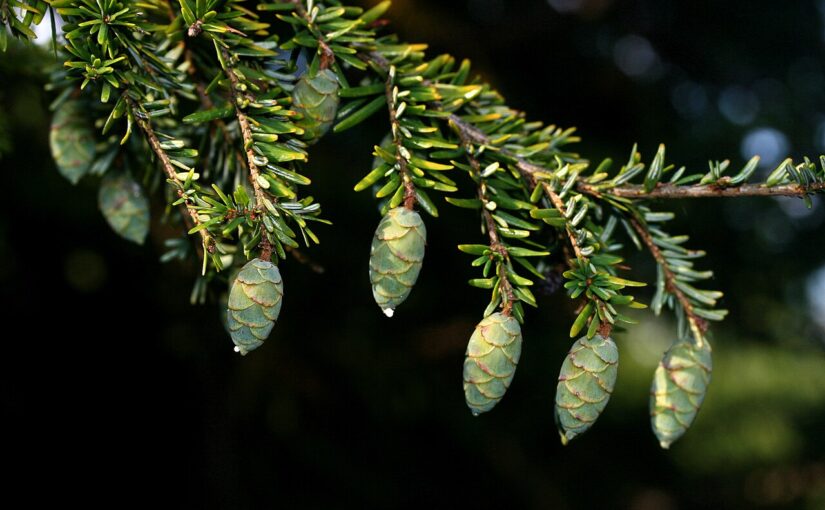Hemlock essential oil, sourced from the needles and twigs of Tsuga canadensis, offers a refreshing essence rooted in the cool forests of eastern North America. Native to Canada and the northeastern United States, this coniferous tree thrives in moist, shaded environments and can live up to eight hundred years, symbolizing enduring strength. The oil is steam-distilled, resulting in a pale yellow to clear liquid with a fresh, piney, and woodsy aroma that serves as a top-middle note in aromatherapy. Its composition includes bornyl acetate, alpha-pinene, camphene, beta-pinene, myrcene, and limonene, which contribute to its respiratory support and anti-inflammatory qualities.
Botanical and Historical Roots
Tsuga canadensis, often called Canadian hemlock or simply hemlock spruce, belongs to the Pinaceae family and stands as a towering presence in its natural habitat. Unlike the toxic herbaceous hemlock from the parsley family, this conifer has been valued by Native American communities for generations. They incorporated it into sweat lodge ceremonies, where its steam was used to enhance immunity and combat infections. The tree’s resilient nature and evocative piney scent recall the vast New England woodlands, evoking a sense of natural purity and vitality. Today, production centers in Canada and the United States, where the oil captures the essence of these ancient forests for contemporary use.
Therapeutic Benefits
Hemlock essential oil provides a range of practical health supports, making it a staple in natural remedies. As an expectorant and antimicrobial agent, it effectively clears mucus and congestion, offering relief for sore throats, colds, flu, and sinusitis. Its antitussive properties calm spastic coughs and soothe bronchial irritation, promoting easier breathing during respiratory challenges. The oil’s anti-inflammatory and analgesic effects target sore muscles, joint pain, and cramps, providing comfort after physical activity or for ongoing tension relief.
With antibacterial and antiseptic actions, hemlock essential oil combats infections, serving as a component in immune-boosting blends or household cleaners. It acts as an immunostimulant, helping the body resist illness, a tradition echoed in its historical applications. As a stimulant and tonic, the oil energizes the system, counters fatigue, and elevates mood, particularly beneficial in colder months when energy levels dip. The presence of bornyl acetate and pinene enhances these effects, positioning hemlock as a forest-derived healer for both physical and subtle wellness needs.
Aromatherapy Applications
Incorporating hemlock essential oil into daily routines is straightforward and versatile. For diffusion, four to six drops in a diffuser with one hundred milliliters of water purifies the air, clears airways, and uplifts the atmosphere. Blending it with black spruce enhances its winter vitality, creating a forest-like ambiance. Topically, dilute five to eight drops in one ounce of carrier oil, such as arnica, for massages that ease muscle cramps, joint discomfort, or tension. Applying the blend to the chest supports respiratory ease.
Direct inhalation works well for quick relief; two to three drops on a tissue or in a personal inhaler address congestion, coughs, or fatigue. Always test inhalation first, especially for those with respiratory sensitivities, to ensure it promotes openness rather than constriction. In baths, six to eight drops mixed with a dispersant in warm water relax muscles and invigorate the body. For cleaning, ten to fifteen drops in a spray bottle with water and vinegar form an effective, antimicrobial solution. Dilution to one or two percent, or six to twelve drops per ounce of carrier, prevents irritation.
Emotional and Energetic Effects
The crisp, woodsy scent of hemlock essential oil invigorates while grounding, helping dissolve mental fog and fatigue. It fosters resilience and clarity, much like sunlight piercing a dense forest canopy, making it suitable for mindfulness practices or overcoming lethargy. Linked to the heart and throat chakras, its yang energy and wood-air elements promote vibrancy and connection, ideal for emotional stagnation or low energy periods.
Blending and Safety Considerations
Hemlock essential oil pairs seamlessly with other coniferous and woody scents, blending well with black spruce, cedarwood, juniper, piñon pine, fir needle, rosemary, bergamot, lavender, and frankincense. Companion oils like black spruce and juniper amplify its grounding effects, while substitutes such as cedarwood or fir needle provide similar respiratory benefits, and eucalyptus aids congestion.
Safety remains paramount with hemlock essential oil. Those with asthma or respiratory conditions should test inhalation by smelling the bottle cap to confirm it eases rather than tightens airways. Proper dilution and patch testing avoid skin irritation, particularly if the oil has oxidized. Ensure the product is Tsuga canadensis to steer clear of the poisonous Conium maculatum. Consult a healthcare provider before use if pregnant, nursing, or for children, due to limited safety data. Store in a dark glass bottle in a cool, dark place for a shelf life of three to five years. Use externally only, avoiding ingestion without professional advice.
Embracing Hemlock’s Forest Wisdom
Hemlock essential oil embodies the timeless vitality of Canadian hemlock, transforming a simple forest breeze into a tool for holistic health. From easing respiratory woes and soothing aches to sparking energy and clarity, it invites users to connect with nature’s enduring strength. In every drop lies the legacy of ancient conifers, supporting modern lives with refreshing, coniferous breath.
Image: Tsuga canadensis immature cones by Liz West from Boxborough, MA.
If your heart finds joy and inspiration here, consider supporting the work that keeps these stories blooming. Your donation, no matter the size, helps sustain authentic research, creative writing, and the spirit of sharing that connects us all.
